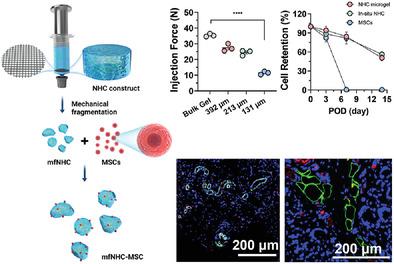Our official English website, www.x-mol.net, welcomes your
feedback! (Note: you will need to create a separate account there.)
Biostimulatory Micro-Fragmented Nanofiber-Hydrogel Composite Improves Mesenchymal Stem Cell Delivery and Soft Tissue Remodeling
Small ( IF 13.0 ) Pub Date : 2022-08-10 , DOI: 10.1002/smll.202202309 Zhi-Cheng Yao 1, 2, 3 , Yueh-Hsun Yang 2, 4 , Jiayuan Kong 1, 2, 3 , Yining Zhu 2, 3, 5 , Ling Li 6 , Calvin Chang 2, 3, 5 , Chi Zhang 1, 2, 3 , Jason Yin 1, 2, 3 , Jeffrey Chao 2, 3, 7 , Florin M Selaru 6 , Sashank K Reddy 3, 4, 5 , Hai-Quan Mao 1, 2, 3, 5
Small ( IF 13.0 ) Pub Date : 2022-08-10 , DOI: 10.1002/smll.202202309 Zhi-Cheng Yao 1, 2, 3 , Yueh-Hsun Yang 2, 4 , Jiayuan Kong 1, 2, 3 , Yining Zhu 2, 3, 5 , Ling Li 6 , Calvin Chang 2, 3, 5 , Chi Zhang 1, 2, 3 , Jason Yin 1, 2, 3 , Jeffrey Chao 2, 3, 7 , Florin M Selaru 6 , Sashank K Reddy 3, 4, 5 , Hai-Quan Mao 1, 2, 3, 5
Affiliation

|
Functional microgels are preferred stem cell carriers due to the ease of delivery through minimally invasive injection and seamless integration with the surrounding host tissue. A biostimulatory nanofiber-hydrogel composite (NHC) has been previously developed through covalently crosslinking a hyaluronic acid hydrogel network with surface-functionalized poly (ε-caprolactone) nanofiber fragments. The NHC mimics the microarchitecture of native soft tissue matrix, showing enhanced cell infiltration, immunomodulation, and proangiogenic properties. Here, injectability of the pre-formed NHC is improved by mechanical fragmentation, making it into micro-fragmented NHC (mfNHC) in a granular gel form as a stem cell carrier to deliver mesenchymal stem cells (MSCs) for soft tissue remodeling. The mfNHC shows a similar storage modulus but a significantly reduced injection force, as compared with the corresponding bulk NHC. When injected subcutaneously in a rat model, mfNHC-MSC constructs initiate an elevated level of host macrophage infiltration, more pro-regenerative polarization, and subsequently, improved angiogenesis and adipogenesis response when compared to mfNHC alone. A similar trend of host cell infiltration and pro-angiogenic response is detected in a swine model with a larger volume injection. These results suggest a strong potential for use of the mfNHC as an injectable carrier for cell delivery and soft tissue remodeling.
中文翻译:

生物刺激微碎片纳米纤维-水凝胶复合材料改善间充质干细胞输送和软组织重塑
功能性微凝胶是首选的干细胞载体,因为它易于通过微创注射进行递送并与周围宿主组织无缝整合。先前通过将透明质酸水凝胶网络与表面功能化的聚(ε-己内酯)纳米纤维片段共价交联,开发了一种生物刺激纳米纤维-水凝胶复合材料(NHC)。 NHC 模仿天然软组织基质的微结构,显示出增强的细胞浸润、免疫调节和促血管生成特性。在这里,通过机械破碎提高了预制NHC的可注射性,使其成为颗粒凝胶形式的微碎片NHC(mfNHC),作为干细胞载体来输送间充质干细胞(MSC)以进行软组织重塑。与相应的块状 NHC 相比,mfNHC 显示出相似的储能模量,但注射力显着降低。当皮下注射到大鼠模型中时,与单独的 mfNHC 相比,mfNHC-MSC 构建体启动宿主巨噬细胞浸润水平升高,促进再生极化,随后改善血管生成和脂肪生成反应。在注射较大体积的猪模型中检测到宿主细胞浸润和促血管生成反应的类似趋势。这些结果表明,mfNHC 作为细胞输送和软组织重塑的可注射载体具有巨大的潜力。
更新日期:2022-08-10
中文翻译:

生物刺激微碎片纳米纤维-水凝胶复合材料改善间充质干细胞输送和软组织重塑
功能性微凝胶是首选的干细胞载体,因为它易于通过微创注射进行递送并与周围宿主组织无缝整合。先前通过将透明质酸水凝胶网络与表面功能化的聚(ε-己内酯)纳米纤维片段共价交联,开发了一种生物刺激纳米纤维-水凝胶复合材料(NHC)。 NHC 模仿天然软组织基质的微结构,显示出增强的细胞浸润、免疫调节和促血管生成特性。在这里,通过机械破碎提高了预制NHC的可注射性,使其成为颗粒凝胶形式的微碎片NHC(mfNHC),作为干细胞载体来输送间充质干细胞(MSC)以进行软组织重塑。与相应的块状 NHC 相比,mfNHC 显示出相似的储能模量,但注射力显着降低。当皮下注射到大鼠模型中时,与单独的 mfNHC 相比,mfNHC-MSC 构建体启动宿主巨噬细胞浸润水平升高,促进再生极化,随后改善血管生成和脂肪生成反应。在注射较大体积的猪模型中检测到宿主细胞浸润和促血管生成反应的类似趋势。这些结果表明,mfNHC 作为细胞输送和软组织重塑的可注射载体具有巨大的潜力。











































 京公网安备 11010802027423号
京公网安备 11010802027423号